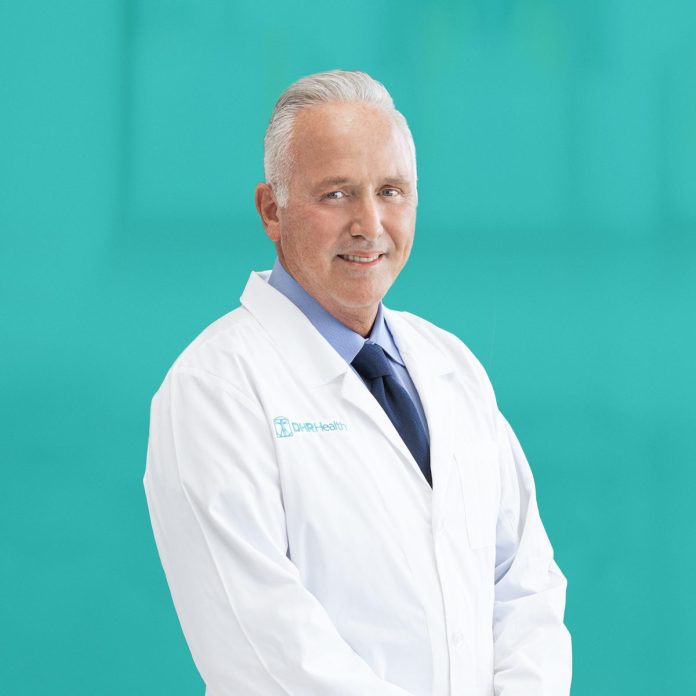By: Dr. Daniel Romanelli
DHR Health Orthopedic Institute
DHR Health Sports Medicine
The shoulder is the most movable joint in the body. It is able to turn in many directions, allowing you to lift your arm, rotate it, and reach over your head. However, this greater range of motion also makes the shoulder susceptible to injury. The shoulder is a complex joint that relies on the surrounding soft tissue structures for stability and strength. These structures include the four muscles of the rotator cuff, as well as the bicep tendons, ligaments, and scapular muscles.
Diagnosis
Injury, overuse, and age-related wear and tear are responsible for most shoulder problems. Shoulder pain (with rest or movement) and general shoulder instability are common symptoms of strains or tears of any of these soft tissue structures. In most cases, your history of symptoms, along with a thorough physical examination by an experienced sports medicine orthopedist, can substantiate a diagnosis. Due to the complexity of the shoulder joint, special tests have been designed to isolate different shoulder problems. These tests can be performed during examination, along with X-rays and an MRI, to confirm the diagnosis of the shoulder injury.
Treatments
Most orthopedists will recommend a conservative, non-surgical approach as the first option for shoulder pain and instability. These may include activity modification, which may require making some lifestyle changes and avoiding some activities; non-steroidal anti-inflammatories to reduce pain and inflammation; and physical therapy to strengthen the shoulder muscles and improve shoulder control. In my practice, I routinely take a whole-body approach and look at the kinetic chain to see if there are any muscle imbalances or weaknesses, which often contribute to the shoulder pain. Oftentimes, the shoulder is the victim, and the culprit usually is a weakness or imbalance of muscles or tendons within the kinetic chain. At that point, physical therapy will concentrate on strengthening your trunk, hip, and core musculature, as well as scapular musculature to get the shoulder to a more normal state. Non-surgical treatment plans may often take a few months before you can tell if they are working.
When Shoulder Arthroscopy is Recommended
Your doctor may recommend shoulder arthroscopy if you have a painful condition that does not respond to non-surgical treatment. Arthroscopy is a minimally invasive procedure orthopedic surgeons use to inspect, diagnose, and repair problems inside a joint by utilizing a thin camera and instruments. The camera and instruments are inserted into the shoulder by a series of small cuts and the shoulder anatomy is visualized on a TV monitor.
Minimally invasive procedures, such as shoulder arthroscopy, make the diagnosis, treatment, and recovery from surgery easier and faster than was once thought possible. Improvements to shoulder arthroscopy occur every year as new instruments and techniques are developed to address different shoulder problems.
Planning for Surgery
If you are generally healthy, your arthroscopy will most likely be performed as an outpatient. This means you will not need to stay overnight at the hospital.
Most arthroscopic procedures take less than an hour. However, the length of your surgery will depend on what your surgeon finds and what needs to be repaired at the time of surgery.
Rehabilitation
Shortly after surgery, the shoulder must be rehabilitated with physical therapy. This will prevent scarring as it heals and will improve the range of motion in your shoulder. Your physician’s ability to prescribe the correct rehabilitation program is equally as important as making the correct diagnosis.
The goal of your rehabilitation program is to restore your shoulder function. Rehabilitation program starting points are widely variable, depending on the type of diagnosis (rotator cuff tears, ligament tears) the type of treatment (nonoperative versus operative), and other associated problems (inflexibility, strength deficits). This point reinforces the need for a complete and accurate diagnosis as a starting point for your rehabilitation.
To set up a consultation, please contact DHR Health Brownsville at 956-362 -5870, or visit us at 4770 N. Expressway, Ste. 305 A, Brownsville, TX 78526.




